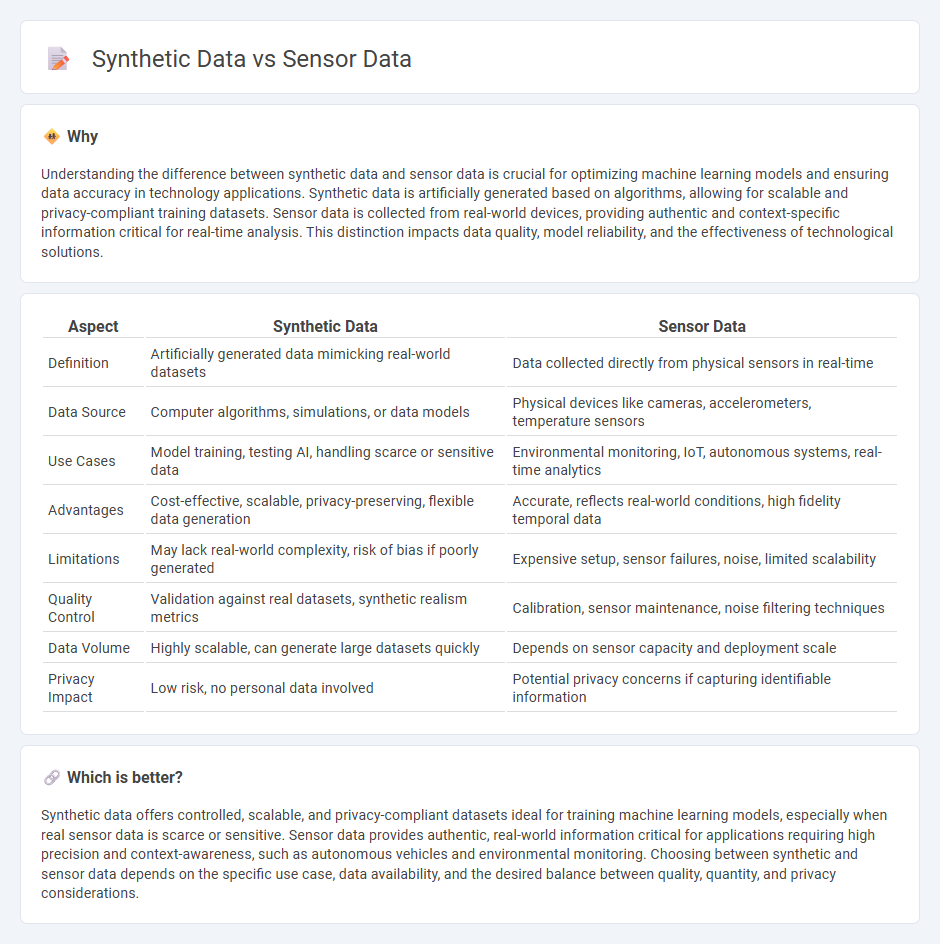
Synthetic data is artificially generated information used to train machine learning models, while sensor data is collected directly from physical devices monitoring real-world conditions. Synthetic data offers privacy benefits and can fill gaps where sensor data is scarce or expensive to gather. Explore how combining both types enhances AI accuracy and robustness.
Why it is important
Understanding the difference between synthetic data and sensor data is crucial for optimizing machine learning models and ensuring data accuracy in technology applications. Synthetic data is artificially generated based on algorithms, allowing for scalable and privacy-compliant training datasets. Sensor data is collected from real-world devices, providing authentic and context-specific information critical for real-time analysis. This distinction impacts data quality, model reliability, and the effectiveness of technological solutions.
Comparison Table
| Aspect | Synthetic Data | Sensor Data |
|---|---|---|
| Definition | Artificially generated data mimicking real-world datasets | Data collected directly from physical sensors in real-time |
| Data Source | Computer algorithms, simulations, or data models | Physical devices like cameras, accelerometers, temperature sensors |
| Use Cases | Model training, testing AI, handling scarce or sensitive data | Environmental monitoring, IoT, autonomous systems, real-time analytics |
| Advantages | Cost-effective, scalable, privacy-preserving, flexible data generation | Accurate, reflects real-world conditions, high fidelity temporal data |
| Limitations | May lack real-world complexity, risk of bias if poorly generated | Expensive setup, sensor failures, noise, limited scalability |
| Quality Control | Validation against real datasets, synthetic realism metrics | Calibration, sensor maintenance, noise filtering techniques |
| Data Volume | Highly scalable, can generate large datasets quickly | Depends on sensor capacity and deployment scale |
| Privacy Impact | Low risk, no personal data involved | Potential privacy concerns if capturing identifiable information |
Which is better?
Synthetic data offers controlled, scalable, and privacy-compliant datasets ideal for training machine learning models, especially when real sensor data is scarce or sensitive. Sensor data provides authentic, real-world information critical for applications requiring high precision and context-awareness, such as autonomous vehicles and environmental monitoring. Choosing between synthetic and sensor data depends on the specific use case, data availability, and the desired balance between quality, quantity, and privacy considerations.
Connection
Synthetic data and sensor data are interconnected through their roles in training and validating machine learning models, where synthetic data supplements real sensor data to enhance data diversity and volume. Sensor data captures real-world environmental information, while synthetic data simulates scenarios difficult to obtain from actual sensors, improving model robustness. Combining both types ensures comprehensive datasets for accurate predictions and reduced bias in technology applications such as autonomous vehicles and IoT systems.
Key Terms
Real-world measurements
Real-world measurements in sensor data capture actual environmental conditions through physical devices, providing high-fidelity and context-specific information crucial for applications like autonomous driving and environmental monitoring. Synthetic data, generated via simulations or algorithms, offers scalable and customizable datasets but may lack the nuanced variability present in real-world conditions. Explore deeper insights to understand the trade-offs between real-world sensor data and synthetic data for your projects.
Data generation
Sensor data is collected in real-time from physical devices such as IoT sensors, providing accurate and context-rich information directly from the environment. Synthetic data is artificially generated using algorithms or simulations to mimic real-world data patterns, often employed to augment datasets or protect privacy. Explore deeper to understand the advantages and applications of each data generation method.
Model validation
Sensor data provides real-world information crucial for accurate model validation by capturing authentic, often noisy conditions encountered in deployment. Synthetic data offers controlled, scalable scenarios that help identify edge cases and improve model robustness through diverse, annotated datasets. Explore further to understand their complementary roles in enhancing model validation strategies.
Source and External Links
Sensor Data: What Is It & How to Use It? | InfluxData - Sensor data is generated when a device detects and responds to input from the physical environment, often producing time series data from various types like temperature, humidity, pressure, and motion sensors commonly used in IoT applications.
What is Sensor Data? Examples of Sensors and Their Uses - Sensor data is the output from devices that detect physical environmental inputs, with examples including accelerometers, photosensors, lidar, smart grid sensors, gyroscopes, and infrared sensors, illustrating a wide range of applications from mobile devices to smart cities.
What does Data Sensor do? - IBM - In an IMS database context, Data Sensors collect statistics about database environments and store this sensor data for analysis, tuning, and autonomic management, functioning as components integrated within IMS Tools products.
 dowidth.com
dowidth.com